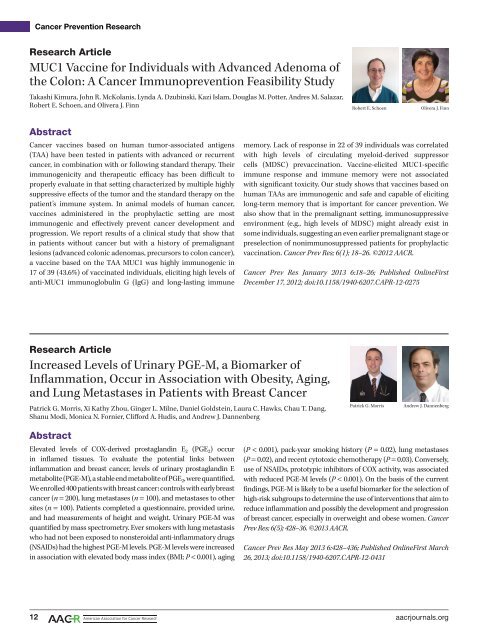Best of AACR Journals
You also want an ePaper? Increase the reach of your titles
YUMPU automatically turns print PDFs into web optimized ePapers that Google loves.
Cancer Prevention Research<br />
Research Article<br />
MUC1 Vaccine for Individuals with Advanced Adenoma <strong>of</strong><br />
the Colon: A Cancer Immunoprevention Feasibility Study<br />
Takashi Kimura, John R. McKolanis, Lynda A. Dzubinski, Kazi Islam, Douglas M. Potter, Andres M. Salazar,<br />
Robert E. Schoen, and Olivera J. Finn<br />
Robert E. Schoen<br />
Olivera J. Finn<br />
Abstract<br />
Cancer vaccines based on human tumor-associated antigens<br />
(TAA) have been tested in patients with advanced or recurrent<br />
cancer, in combination with or following standard therapy. Their<br />
immunogenicity and therapeutic efficacy has been difficult to<br />
properly evaluate in that setting characterized by multiple highly<br />
suppressive effects <strong>of</strong> the tumor and the standard therapy on the<br />
patient’s immune system. In animal models <strong>of</strong> human cancer,<br />
vaccines administered in the prophylactic setting are most<br />
immunogenic and effectively prevent cancer development and<br />
progression. We report results <strong>of</strong> a clinical study that show that<br />
in patients without cancer but with a history <strong>of</strong> premalignant<br />
lesions (advanced colonic adenomas, precursors to colon cancer),<br />
a vaccine based on the TAA MUC1 was highly immunogenic in<br />
17 <strong>of</strong> 39 (43.6%) <strong>of</strong> vaccinated individuals, eliciting high levels <strong>of</strong><br />
anti-MUC1 immunoglobulin G (IgG) and long-lasting immune<br />
memory. Lack <strong>of</strong> response in 22 <strong>of</strong> 39 individuals was correlated<br />
with high levels <strong>of</strong> circulating myeloid-derived suppressor<br />
cells (MDSC) prevaccination. Vaccine-elicited MUC1-specific<br />
immune response and immune memory were not associated<br />
with significant toxicity. Our study shows that vaccines based on<br />
human TAAs are immunogenic and safe and capable <strong>of</strong> eliciting<br />
long-term memory that is important for cancer prevention. We<br />
also show that in the premalignant setting, immunosuppressive<br />
environment (e.g., high levels <strong>of</strong> MDSC) might already exist in<br />
some individuals, suggesting an even earlier premalignant stage or<br />
preselection <strong>of</strong> nonimmunosuppressed patients for prophylactic<br />
vaccination. Cancer Prev Res; 6(1); 18–26. ©2012 <strong>AACR</strong>.<br />
Cancer Prev Res January 2013 6:18–26; Published OnlineFirst<br />
December 17, 2012; doi:10.1158/1940-6207.CAPR-12-0275<br />
Research Article<br />
Increased Levels <strong>of</strong> Urinary PGE-M, a Biomarker <strong>of</strong><br />
Inflammation, Occur in Association with Obesity, Aging,<br />
and Lung Metastases in Patients with Breast Cancer<br />
Patrick G. Morris, Xi Kathy Zhou, Ginger L. Milne, Daniel Goldstein, Laura C. Hawks, Chau T. Dang,<br />
Shanu Modi, Monica N. Fornier, Clifford A. Hudis, and Andrew J. Dannenberg<br />
Patrick G. Morris<br />
Andrew J. Dannenberg<br />
Abstract<br />
Elevated levels <strong>of</strong> COX-derived prostaglandin E 2 (PGE 2 ) occur<br />
in inflamed tissues. To evaluate the potential links between<br />
inflammation and breast cancer, levels <strong>of</strong> urinary prostaglandin E<br />
metabolite (PGE-M), a stable end metabolite <strong>of</strong> PGE 2 , were quantified.<br />
We enrolled 400 patients with breast cancer: controls with early breast<br />
cancer (n = 200), lung metastases (n = 100), and metastases to other<br />
sites (n = 100). Patients completed a questionnaire, provided urine,<br />
and had measurements <strong>of</strong> height and weight. Urinary PGE-M was<br />
quantified by mass spectrometry. Ever smokers with lung metastasis<br />
who had not been exposed to nonsteroidal anti-inflammatory drugs<br />
(NSAIDs) had the highest PGE-M levels. PGE-M levels were increased<br />
in association with elevated body mass index (BMI; P < 0.001), aging<br />
(P < 0.001), pack-year smoking history (P = 0.02), lung metastases<br />
(P = 0.02), and recent cytotoxic chemotherapy (P = 0.03). Conversely,<br />
use <strong>of</strong> NSAIDs, prototypic inhibitors <strong>of</strong> COX activity, was associated<br />
with reduced PGE-M levels (P < 0.001). On the basis <strong>of</strong> the current<br />
findings, PGE-M is likely to be a useful biomarker for the selection <strong>of</strong><br />
high-risk subgroups to determine the use <strong>of</strong> interventions that aim to<br />
reduce inflammation and possibly the development and progression<br />
<strong>of</strong> breast cancer, especially in overweight and obese women. Cancer<br />
Prev Res; 6(5); 428–36. ©2013 <strong>AACR</strong>.<br />
Cancer Prev Res May 2013 6:428–436; Published OnlineFirst March<br />
26, 2013; doi:10.1158/1940-6207.CAPR-12-0431<br />
12<br />
aacrjournals.org



